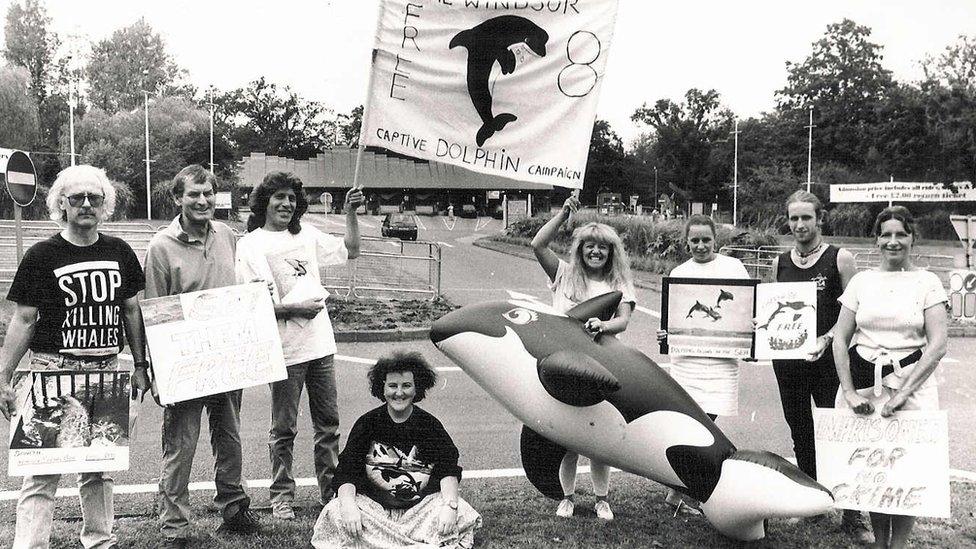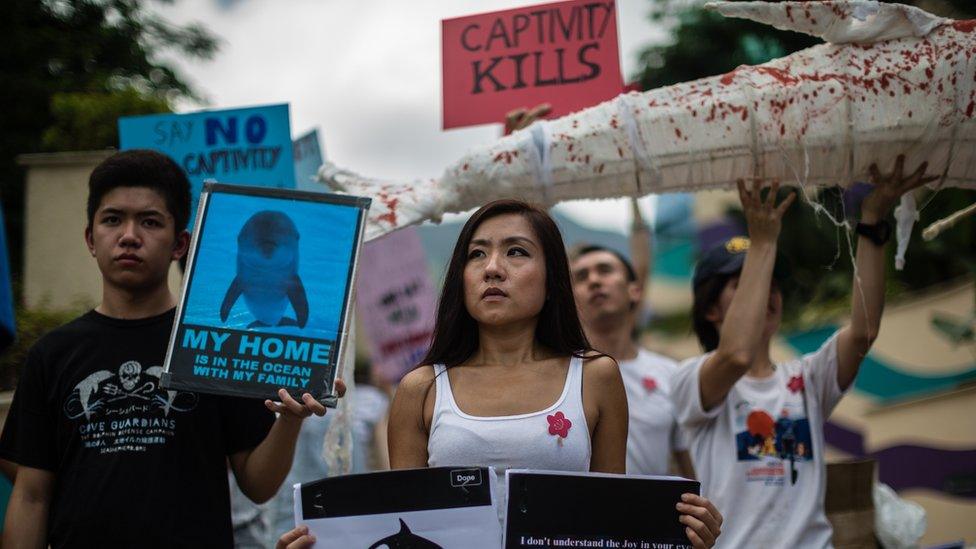Dolphins on display: How UK's 'Seaworlds' sank
- Published

US theme park SeaWorld's decision to end its controversial orca breeding campaign has been welcomed by many. However, in the UK, shows featuring captive dolphins stopped more than 25 years ago.
They were once a common sight at tourist attractions from Brighton to Morecambe, but by the early 1990s the UK's dolphinariums were a thing of the past.
Following an animal rights campaign called "Into the Blue" which attracted widespread popular support, the government made standards of care so stringent no dolphinarium in the country could afford to meet them.
Perhaps strangely, it is not illegal to keep dolphins in the UK, but the country is still regarded as a "shining example in the anti-captivity world," says Margaux Dodds, director of the Marine Connection charity and one of the successful campaigners in the 1980s.
"We used to stand outside the parks in protest. We had dolphin suits and would hand out leaflets about how these animals would live in the wild," she says.
"Eventually our message was heard. I think that's what has happened to SeaWorld - the share prices fall, the takings fall, there are protests, and with social media added in now, the public opinion changes."

Margaux Dodds protested outside of the Windsor Dolphinarium every weekend in the late 1980s

A dolphin named 'Smartie' was photographed by Margaux Dodds at one of the dolphin-holding pens at Windsor Dolphinarium
Between the 1970s and the 1990s there were more than 30 dolphinariums in the UK, housing about 300 dolphins.
However, experts now accept that captivity is very harmful to them.
Toby Forer, general manager of the Sea Life London Aquarium, said cetaceans - whales, dolphins and porpoises - should not be kept in captivity.
"They have complex social structures and sensory capacities and a wide geographic habitat," he says.
"It is therefore extremely difficult to meet their needs in manmade environments.
"We are conscious of our obligation to display only those species which adapt well to good quality captive displays. Educational displays which allow people to see the living creatures first hand can be invaluable in raising awareness of, and support for, conservation endeavours."


Missie and Silver, from the Brighton Dolphinarium, and Rocky, from Morecambe Marineland, were released back into the wild in the Caribbean
History of UK Dolphinariums
1970s: Known to be at least 36 dolphinariums and travelling dolphin shows
1980s: Only five dolphinariums remained
1985: A review of dolphinariums in the UK revealed major inadequacies in the conditions under which cetaceans were being kept
1987: A joint report by the Born Free Foundation and the Whale and Dolphin Conservation Society exposed the poor conditions in which many of Britain's dolphins were kept
1991: A campaign was launched called Into the Blue, in which animal welfare groups campaigned together to close the UK's remaining dolphinariums

Should the remaining captive dolphins just be released into the wild to enjoy their retirement?
The Seaworld dolphins will not be swimming free - the corporation announced it would end its orca breeding programme, meaning orcas currently at the parks will be "the last generation".
Dr Simon Ingram, a lecturer in marine conservation at Plymouth University, said animals kept in captivity would not survive if they were released in the wild.
"I'm an advocate of viewing animals in a natural habitat, it's a much better way of appreciating them. I'd like to think we have moved on from using dolphins as entertainment.
"How would you define a sanctuary - even a pen in the wild would still mean captivity. Bottlenose dolphins need to live in large social groups and be able to mix freely through the community."

Dolphins were a regular sight at UK tourist attractions. Here is one in Blackpool with a young Cilla Black
Ms Dodds also has concerns about the future for the dolphins which have been kept in captivity.
"Not every dolphin or whale could be introduced into the wild, they need to be somewhere they don't have to perform and kept in small cages.
"The captivity world needs to do something to help the animals they have profited from.
"When parks close we need sanctuaries for when animals come out and to live in a more natural environment. Companies like SeaWorld need to step up and be a part of the solution, as they are responsible for the problem," she said.
The captivity of dolphins across the world continues in the Middle East, Russia and China.
Margaux Dodds said: "This news from SeaWorld gives me real hope for the future. We might not see the end to captivity in our lifetime but we may be able to see the steps towards it.
"We might not win the war, but we will take it one battle at a time."

Animal rights activists protest against the captivity of dolphins outside local theme park Ocean Park during an 'Empty The Tanks' event in Hong Kong

The fate of UK Dolphinariums
Battersea Park Dolphinarium: 1971 - 1973
Blackpool Dolphinarium - 1969
Blair Drummond Safari Park Dolphinarium: 1974 - 1984
Brean Down Dolphinarium - 1974
Brighton Aquarium & Dolphinarium: 1968 - 1990
Clacton Pier Dolphinarium: 1971 - 1985
Cleethorpes Marineland & Zoo: 1966 - 1974
Coventry Zoo Dolphinarium: 1972 - 1975
Dudley Zoo - Dolphins & Whales: 1971 - 1974
Flamingoland: 1963 - 1993
Gwrych Castle: 1970
Knowsley Safari Park Dolphinarium: 1972 - 1985
London Dolphinarium: 1971
Margate Dolphinarium
Marineland: 1964 - 1990
Ocean Park: 1973 - 1975
Porthcawl Dolphinarium: 1971 - 1974
Rhyl Dolphinarium: 1972 - 1974
Royalty Folies - 1974
Sandown Dolphinarium - Isle Of Wight
Scarborough Marineland & Zoo: 1969 - 1984
Skegness Dolphinarium: 1972 - 1975
South Elmsall Animal Training School And Dolphinarium: 1972 - 1974
Southend Dolphinarium - 1970 - 1975
Southsea Dolphinarium: 1973
West Midlands Safari Park Dolphinarium: 1975
Weymouth Dolphinarium: 1971
Whipsnade Zoo - Zoological Society of London: 1972 - 1988
Windsor Safari Park: 1970 - 1992
Woburn Dolphinarium: 1973 - 1983
Source: UK Dolphinaria Archive, external

- Published17 March 2016

- Published30 August 2015

- Published20 May 2015

- Published30 October 2013

- Published21 February 2012
